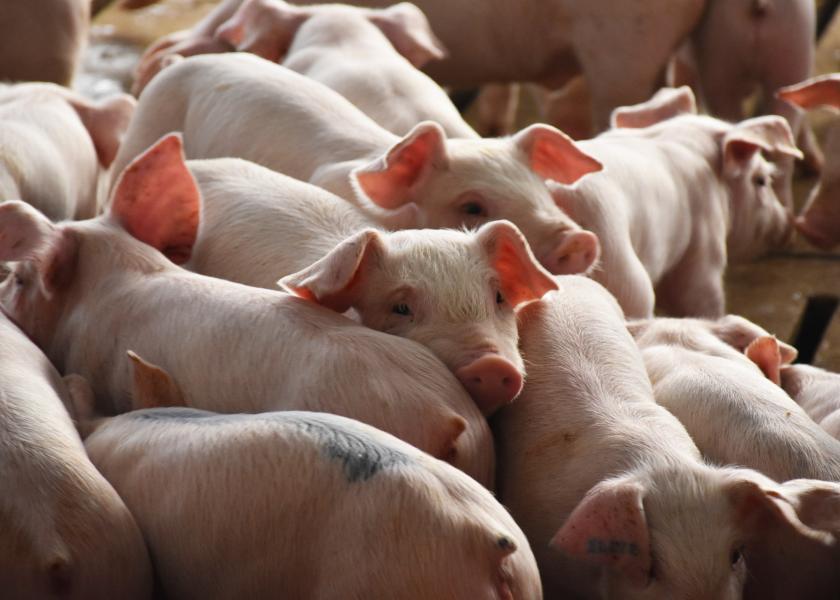Porcine Sapovirus: Why Diagnostic Diligence is Crucial

Narrowly focusing on a single pathogen during a diagnostic investigation is risky, experts agreed during a recent webinar on porcine sapovirus (PSaV), a potentially emerging disease. During the webinar, hosted by the Swine Health Information Center and American Association of Swine Veterinarians, presenters said a narrow focus could result in missed detections of emerging or less common pathogens. That's why a definitive lab diagnosis is necessary to know which pathogen or combination of pathogens are the cause of clinical disease in your swine herd.
Tom Petznick, DVM, a practitioner with ArkCare in Omaha, Neb., shared about a discovery of PSaV on a client’s farm. Clinical signs on the farm included diarrhea and reduced average daily gain in pigs 7 days of age and older. Specifically, diarrhea was gravy to toothpaste-like in consistency and grey, yellow, yellowish-brown in color, he said. Disease was self-limiting at or shortly after weaning with high morbidity/low mortality. The pigs didn’t respond to treatment. While there was low mortality, some pigs were too light at weaning and morbidity was variable. Affected pigs exhibited 1.5 pounds of lost wean weight.
Petznick pursued a definitive diagnosis in his client’s herd with planning, sample collection and follow-up analysis.
"Initial results were negative for the usual causes – rotavirus, PEDV, PDCoV and TGEV. The pursuit of a diagnosis continued with collaboration from Iowa State University’s Veterinary Diagnostic Lab, Merck Animal Health’s Sequivity division, the producer, and the Swine Health Information Center Diagnostic Fee Support," SHIC said in a release.
Next generation sequencing unexpectedly found PSaV. Although PSaV was identified in the U.S. in 1980, the virus had not been identified as a significant cause for diarrhea in U.S. herds for decades. After implementing environmental analysis, sanitation and controlled/timed exposure in an unsuccessful effort to control the PSaV, Petznick investigated vaccination.
In a four-step process including review of previous data, identifying the sample subject, analyzing fecal shedding vs weaning weight, and performing a vaccine field trial, the proof of concept was completed, SHIC said in a release. In the field trial, experts observed almost complete disappearance of diarrhea and weaning weights increased.
"While other farms Petznick serves had similar clinical signs in pigs, the causative agents differed. Four farms in a swine production system were diagnosed with coccidiosis, sapovirus, rotavirus, and a co-infection of sapovirus/rotavirus, respectively. Diligent pursuit of diagnosis led to appropriate treatment and care," SHIC reported in a release.
Meanwhile, Will Fombelle, DVM, a practitioner with Carthage Veterinary Service, LTD, shared another field perspective. His observation included mid- to late-lactation piglet diarrhea which presented as could be expected with multiple pathogens, especially coccidia. Pudding-like diarrhea, rough hair, weaning weight deficits and low mortality were all observed.
Fombelle pointed out that it would have been easy to assume the diarrhea and low weaning weights were the result of coccidiosis. He was surprised to learn that wasn't the cause. By ruling out coccidia, they needed to “rule something in.” The process grew to include tissue submission, rectal swabs and fecal flotations.
Economics were considered in their evaluation. Fombelle said the cost of a weaning weight loss of 1 pound would equate to $22 per sow per year. This helped guide decision-making for treatment. He pointed out that vaccines with favorable efficacy are available to manage PSaV and recommended other practical management strategies as well.
Marcelo Almeida, DVM, of the Iowa State University Veterinary Diagnostic Lab, discussed PSaV characteristics and the results of work done to identify the causative agent from Petznick’s client’s herd outbreak. The epidemiology of PSaV shows it can be detected in pigs both with and without diarrhea and as such, but detection does not equal causation. He also shared that PSaV can infect pigs at any age, but detection rates are higher during suckling and nursery phases. Transmission is fecal-oral, Almeida said. Early detection of PSaV in piglets is common but questions remain surrounding sow-to-piglet transmission and environmental contamination. For disinfection, he recommended sodium hypochlorite at 2.5 mg per liter for 30 minutes.
Almeida said samples should come from acutely affected pigs. Fresh and fixed samples of small intestines and colon are needed as well as feces. Tests used for diagnosis include histopathology, PCR and RNAscope. Differentials for PSaV diagnosis are enteric coronaviruses, rotavirus, Cystoisospora suis and others.
The webinar can be viewed here.







